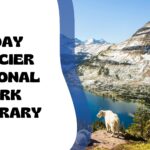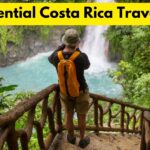Hello everyone ,I’m Avnish. I’m extremely excited to share with you all of the tips for Costa Rica, my favorite country in Latin America. I have visited Costa Rica seven times, the first time way back in 2002 when I was a 14-year-old surf Grom. That first visit to Costa Rica really solidified my love for the Spanish language, for surfing, and for the country of Costa Rica. So I’m really excited to share all the tips that I’ve learned from multiple visits to this beautiful Central American nation in this video.
Before we get started, make sure that you’re subscribed with notifications enabled so you don’t miss any future articles, and if you’re enjoying this article, please give it a share. Alright, let’s go. Should we start?
History and Facts
So let’s start things off with a couple of fast facts. Costa Rica is by far and large the most popular tourist destination in Central America. Over 80% of visitors come from the United States, and in 2018, there were over three million visitors coming to Costa Rica. The country is small, it’s only the size of West Virginia, but don’t be fooled by its diminutive size. It’s the most biodiverse country in the world.
Costa Rica is located in Central America and is bordered in the north by Nicaragua and in the south by Panama. It’s got the Pacific Ocean on its west coast and on its East Coast, it has the Caribbean Sea. It’s divided into seven regions: San Jose, Alajuela, Heredia, Cartago, Guanacaste, Punta Arenas, and Limón.
The name Costa Rica derives from Spanish and it means rich coast because the first Spaniards who arrived in Costa Rica were greeted by natives who were wearing elaborate gold rings in their ears and noses. Speaking of those original inhabitants, archeologists have found evidence that shows habitation from humans over 10,000 years ago.
In the 1500s, Christopher Columbus stopped in Costa Rica on his final voyage, and it became a colony of Spain, but after that, it was pretty much neglected. The Spanish didn’t find the riches that they were looking for in Costa Rica, so it became this kind of periphery in the Spanish colonial empire. In 1821, Costa Rica followed Mexico’s lead and declared independence from Spain, becoming a sovereign nation in 1824.
Since then, the country has evolved immensely. It’s one of the leaders in conservation globally because of its biodiversity. It’s also a leader in ecotourism, and it’s one of the most amazing destinations in the Americas. So let’s get into the tips.
1. Cost And Expenses
Unfortunately, Costa Rica is not that cheap because it’s one of the safest countries in Latin America. It doesn’t have a standing army and it has relatively low crime rates compared to its neighbors. It’s become the go-to destination for Gringos, primarily from the United States, to go on vacation.
Costa Rica’s popularity has translated into higher prices across the board, so if you’re trying to keep your costs low, then I would suggest avoiding the large group tours. I’m talking about ziplining canopy tours, ATV tours, things of those nature.
Now, that might be fun, and if you have the budget to allocate to that, then by all means go right ahead. Ziplining through the forest in the Costa Rican canopy is really cool, and you can see lots of wildlife, but it is expensive.
Most bills when eating out, even at small restaurants, are going to include a 10% service tip and a 13% tax, but the good news is you don’t have to tip on top of that. Also, for visiting most natural sights, you’re probably gonna have to pay a small fee between ten and twenty dollars, usually for parking and security.
So even if you’re rolling up on a waterfall in the middle of nowhere, someone has set up a small business that has a parking lot, and you’re gonna have to pay for parking. That also essentially is like a security charge; you pay for that so that the security guard keeps your car and your belongings safe while you are bathing.
2.Avoid Crowd
Avoid the crowds if you can. The low season in Costa Rica is May to December; this is the rainy season in the country. Costa Rica doesn’t have four seasons like temperate places in the northern and southern hemisphere because Costa Rica is very close to the equator; it only really has two seasons, the rainy season and the dry season.
Now, I visited both in the dry and in the rainy season. Essentially, in the rainy season, it’s gonna rain pretty much every single day, but these are small, for the most part, tropical storms that get a little bit of rain maybe in the morning and then clear out by the afternoon for a nice sunset.
It does make for very dramatic photos during the rainy season. The dry season is much drier; it’s much dustier, and it’s hotter. So I have visited in both the wet and the dry season. Personally, I prefer to visit during the low season, during the rainy season.
If you are going to visit during the rainy season, I highly recommend avoiding the month of October, this is the rainiest month of all. Avoid October if you can.
Also read: Once in a lifetime things to do in Los Angeles
3.Accommodation.
So Costa Rica has the whole gamut of accommodation, everything from little family-run bed and breakfasts to large international global chains. I’ve stayed in many small family-run hotels right on the beach; these are great options.
I highly recommend if you’re trying to go surfing, visit my friends over at Surf Inn Hermosa at Playa Hermosa Beach. But the last time that I visited, my fiancee Carrie and I stayed in an Airbnb down in the south of the country, in multiple different Airbnbs, actually, and that was the most gratifying way for me personally to travel. So choosing sites that aren’t on everybody’s list is really gonna help you save money with your accommodation.
4.Renting a car
Absolutely essential. Costa Rica does not have great public transportation; pretty much just buses, and the roads are very windy and can be quite dangerous. So rent a car; I highly recommend you get insurance because drivers in Costa Rica, especially the truck drivers, drive quite aggressively on single-lane narrow roads with twists and curves and cliffs.
Also, do not speed because there are speed traps all over the place; the police in Costa Rica are well aware that there are many Gringos who have rented cars who might be going a little bit fast, and therefore you will get pulled over; you will have to pay a small fine, which is kind of essentially a bribe to be let go and let on your wet drive.
Drive the speed limit, stay super alert, and be careful when you are passing cars. When I went on my first trip to Costa Rica when I was 14, I got in a car crash; I was in the backseat of a truck. They tried to pass a semi-trailer, and there was another semi-trailer coming straight at us, and we just barely managed to make it into that gap, but we were clipped. It could have been much worse; I was very lucky. I did have a huge welt on my head and had to go to a hospital; luckily, they have great hospitals, so drive carefully!
5.Seasons
Get prepared to be wet. Now, even in the dry season, it does rain occasionally. It is a tropical lush country, and that is due to the amount of rain that it receives, but even when it’s not raining, it can be extremely humid. So wear clothes that breathe well, like linens or synthetic materials.
Having clothes that dry quickly, that wick moisture, and that breathe is very, very important, as is bringing a light shell rain jacket to keep you dry when it does rain. Mornings tend to have the best weather as well, so if there’s something that you’re trying to do like a hike where you’re gonna be active and sweating, I highly recommend that you do that towards the beginning of the day.
6.Volcanoes
Costa Rica is a highly active volcanic region, and these volcanoes really do dictate the weather systems in the country, especially in the highlands. One of the benefits of volcanic activity are hot springs. And if you go to the town of Arenal, there are quite a lot of hot springs to choose from.
This last time that I visited, I had the pleasure of staying in Tabacon Hot Springs Resort; this place is literally heaven on earth. If you have a bit of a budget to splurge, I highly recommend staying there for at least a night. But you can also pay and get access to the thermal River; it’s essentially a hot river that comes down through this beautiful jungle, and you can soak, and it’s just one of the most magical and fantastic hot spring experiences you will ever have. So when you go to Arenal, do not miss out on the hot springs.
Arenal is also one of the top ten most active volcanoes in the world, although it has been dormant for the last seven years, so don’t be alarmed if you smell sulfur, but definitely, it’s worth Googling before you visit what the volcano is doing.
7.Wildlife
Costa Rica is one of the most biologically diverse countries on earth. It only takes up 0.03% of the Earth’s surface, but over 5% of Earth’s species call Costa Rica home. Costa Rica is also leading the way in conservation in Central America; over 25 percent of Costa Rica’s landmass is protected in national parks. That means for visitors that there are over 100 protected wildlife areas to visit.
So if you’re into bird-watching or just being out in nature, you’re quite literally spoiled for choice in Costa Rica. Monkeys are the most common mammal, but be careful; Howler monkeys can be territorial and aggressive. You’ll probably hear their noise coming from the canopy; it sounds something like [howler monkey noise].
So when you hear that, you know it’s a howler monkey, not just like some angry ogre in the forest. I’m sorry, Shrek. And also be aware if a howler monkey is right above you; do not antagonize it because they do, as monkeys do, which means sometimes they defecate in their hands and have been known to throw that defecation at you. So be careful; howler monkeys do throw poop.
It’s also home to 52 different types of hummingbirds, and if you know how to say hummingbird in Spanish, write it down there in the comment section. Costa Rica is also home to over 750,000 different species of insects; that’s over three-quarters of a million different types of insects.
It’s home to more than 10% of the world’s butterflies. So if you’re afraid of creepy crawlies, then definitely be aware; Costa Rica has a lot of bugs, they’re very big, and they do occasionally, from time to time, make their way into your hotel room. Also, there are mosquitoes, so make sure you bring a solid mosquito repellent, and make sure that you bring that from home because that, along with sunscreen, is quite expensive in Costa Rica; it’s marked up a lot because locals don’t really buy either of those products, only gringos do, so the prices are quite inflated. But make sure that you’re putting that on your ankles, your wrists, the back of your neck because mosquitoes definitely love gringo blood.
One of the best ways to deal with the mosquitoes, though, is to wear long-sleeve long leg clothing. Lastly, I recommend visiting the Osa Peninsula if you can; it is quite literally the most biodiverse place on planet earth. It’s very rugged; it’s quite an adventure to get there, but there are some very unique eco hotels out on the peninsula as well as a really good wave called Matapalo where you can stay and surf.
It’s a journey to get there; it required us crossing a river on a floating barge, which was quite an adventure in itself. But it’s a beautiful region, and it is the most biodiverse place on earth, so if you’re into different animals and different plant species, then head to the Osa Peninsula.
8.Beaches
There are over 801 miles of coastline and over 300 different beaches to choose from. Any way you look at it, a trip to Costa Rica has plenty of coastline for you to explore, plenty of beaches for you to lounge and luxuriate at, and if you’re a surfer like myself, then you are spoiled for choice with waves.
Some of the best surf waves that I’ve experienced in Costa Rica are Playa Hermosa just outside of Jaco, Ollie’s Point and Witches Rock, which require a boat trip from Tamarindo, and then also in the south, Pavones, a mythical left Point Break that is kind of fickle; it doesn’t get swell very often, but when it does, it is an incredible wave, and I got very lucky this last trip to be able to catch it with a good swell.
So there’s also the wave Matapalo on the Osa Peninsula, but there are plenty of waves to choose from in Costa Rica, both on the Pacific and on the Caribbean side. If you want beaches without the crowds, then you should head to the Caribbean side of Costa Rica, home to a more diverse Afro-Caribbean culture. It’s also home to some incredible sights that are worth seeing. Head to Porto Viejo and check out the Jaguar preserve there as well as Finca La Isla Botanical Garden.
9.Cloud Forests
Besides volcanoes, the other thing that Costa Rica is very well known for internationally are its cloud forests. Cloud forests are very unique ecosystems; they’re high alpine forests that have 100 percent humidity. This humidity creates a haze that people often say is like walking through a cloud. This unique humid environment leads to some very incredible biodiversity in the cloud forests themselves.
Also, remember that the cloud forests are much cooler and more wet, so make sure that you have a jacket, something to keep you warm because the temperatures are much cooler than down in the lowlands by the beach.
10.San Jose
San Jose is actually quite a young city. It remained essentially a village until well into the 1800s. Now, over one-third of the population of Costa Rica, “Tico’s” or “Ticas” as they’re known, live in San Jose and the surrounding suburban areas. The main airport to the country is in San Jose, unless you’re flying into Tamarindo and Guanacaste.
Personally, I’m not a huge fan of San Jose, but things have been changing; it’s modernizing, it’s getting safer, and there are more food options now, including a craft brewery. But for me personally, I don’t spend all that much time in San Jose; when I land, I rent a car and I head straight to the coast.
11.Coffee
Costa Rica is known internationally for the quality of its coffee beans, and coffee is still a major draw in Costa Rica as well as one of its largest exports. Coffee has played a huge role in the country’s political, economic, and cultural development. Coffee growing took off in the late 1700s and created what were known as coffee barons. The “golden bean” is still a prized export, but coffee production has become much more small-scale. Also, most coffee plantations in Costa Rica have some form of tour with a tasting available for tourists.
12.Get off the beaten path
This last trip to Costa Rica, my fiancee and I spent a bit of time in Playa Hermosa surfing, and then we drove the whole length of the Pacific coast down to Pavones on the southern border of the country. It was quite an amazing road trip.
Getting off the beaten path in Costa Rica is really gonna open up new experiences for you. It’s gonna bring your budget down because you’ll be staying farther away from the touristic centers, and it’s really just gonna give you a more authentic Costa Rican experience, a real taste of the Pura Vida, as they say there.
If you get a chance, I highly recommend that you visit a turtle hatchery. So some of these beaches in Costa Rica are home to returning sea turtles who nest and give birth to their young there. Depending on what time of year you visit, you can see the turtles coming in from the sea to lay their eggs or the young newly hatched turtles emerging from the nests and climbing down to the beach to begin their lives in the ocean.
Either way you do it, it’s a really magical experience and it’s gonna give you a whole new appreciation for the life of a sea turtle and the beautiful birth of these incredible aquatic creatures. That being said, many of these beaches are protected, and you can’t visit without a guide, so look into that for yourselves depending on which region you’re visiting.
13.Eat like a local
I am a huge fan of the “Plato Typico,” as they say, or the Casados, which literally means married because these are the plates, the typical dishes of families, something that your wife would make you back in the day. It usually consists of a protein, whether it’s a “Bistec,” a steak, “Pollo,” chicken, or some fish alongside some rice and black beans with some plantains.
As well as breakfast of “Gallo Pinto,” which is kind of like a little mixed fried rice breakfast, fried rice with some eggs on the side. Lizano salsa, the green salsa, is just life-changing; it’s just so, so good, especially after a morning of surfing. So I highly recommend that you try that out when you visit Costa Rica.
Okay, ladies and gentlemen, those are my tips for Costa Rica. I am a huge fan of Costa Rica; the Ticos and the Ticas that I have met in my life have always been extremely hospitable and kind. So please, when you visit, make sure that you’re respectful to the locals and that you respect the environment because Costa Rica is just such a unique country, and it deserves as much conservation and best behavior as we can give it.
So, please, when you visit, just remember, be respectful, be good travelers, and you will have an amazing time experiencing the “Pura Vida” or the Pure Life. If you enjoyed this video, please give it a big thumbs up, share it with your travel buddies, hit that subscribe button with notifications enabled if you have not already, and please, I’d love to hear your tips for Costa Rica down there in the comment section because I know I’m ready to go back right now. I just write this article and I’m like, it’s time for me to visit again.
Thank you very much; we’ll see each other in the next article, and… I love you. Bye everybody, as I always say, “Train harder, fail smarter, and never give up.” I’ll see you all on the next one. Peace.





